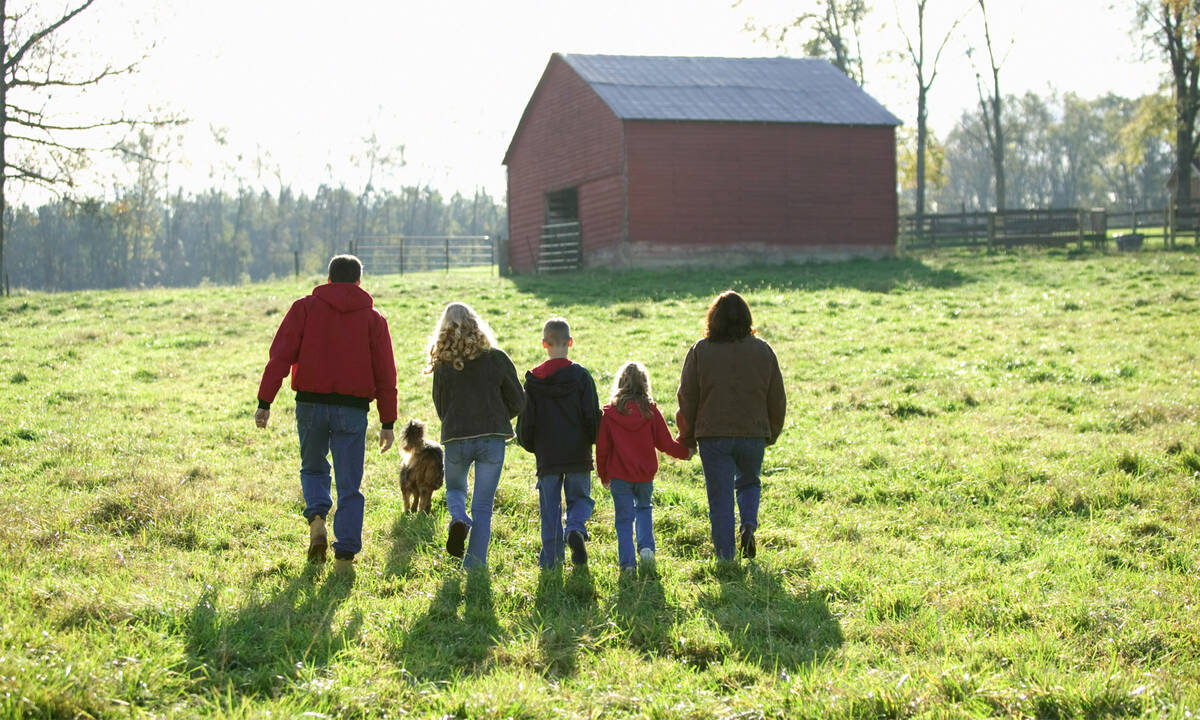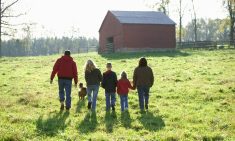Craig Dobbins gets straight to the point. “In most farmland rental agreements,” the ag economist at Purdue University says, “both parties have real difficulty in knowing where the rent should be set.”
In many parts of the country, there’s an equally straight-to-the-point answer, Dobbins says. That’s that fair rent is however high the farmers in your area will bid up the price.
Dobbins isn’t so sure.
“Until growers understand that a fair rent is not achieved by simply outbidding your neighbour, land rental rates will continue to be inequitable,” Dobbins says.
Read Also

Tips for how to be fair to all siblings during farm succession
family walking through a field
Dobbins has a different approach. “A fair rental rate,” he says, “is one that rewards both the tenant and the landlord on the basis of the resources each party brings to the arrangement, AND the risk that each party takes.”
“Factoring risk into the rental rate is especially important in uncertain economic times and when prices are volatile,” Dobbins continues. “As risk increases, the rewards should be larger. Before deciding price, both parties need to decide how much risk they are willing to bear.”
Allocation of risk varies with the type of lease agreement. A cash-rental agreement places essentially all the production and pricing risk on the tenant. The only risk to the landowner is the risk of the tenant not paying the specified fixed rent.
At the other end of the spectrum is a custom-farming agreement. There, all production and price risk falls on the landlord with the only risk to the tenant being nonpayment by the landlord of the contracted farming services.
Based on risk alone, the returns to the tenant should be higher under a cash rent than when custom farming. The opposite is true for landlords who have their land custom farmed. Because they take on more risk, their returns from farming the land should be higher than if they simply rented the land out for a fixed cash rent.
Crop share and flexible cash leases share the risk between the landlord and tenant, so the expected returns for landlords under these arrangements should be higher than if they had cash rented the land, but lower than the expected returns from having the land custom farmed. Tenants should expect higher returns from crop sharing than if they custom farm the land, but lower returns than had he cash rented the land.
The take-home, says Dobbins, is that landlords shouldn’t expect the same return per acre with a cash rent as they can make with a crop share, just as farmers don’t expect the same take-home from custom farming as from cash renting.
So how is a fair rent calculated? Ted Nibourg, business management specialist for Alberta Agriculture is often called on to help growers and landowners hammer out an equitable land lease agreement. Nibourg says, with some understatement, “Often this is not an easy task.”
One of the problems is landowners may expect a set percentage return on the value of the land. “There isn’t a quarter of agricultural land that will pay for itself from farming,” Nibourg says. He believes that such an approach is based on a fallacy.
“Land purchases are an investment,” Nibourg says. “Landowners capture the return on that investment in land when the land is sold, not when they rent the land out for agricultural production.”
Land has always been considered a good investment and over time the returns to land ownership have exceeded the returns from agricultural production. In fact, because of land appreciation, the percentage returns from farming operations has actually been dropping as the value of land has been rising. An Iowa State University study found cash-rental rates as a percentage of total land value fell steadily from 6.6 per cent in 1997 to 4.4 per cent in 2006.
Yet over these same 10 years, the average return to a landowner when rent and appreciation were combined was 13.2 per cent.
Calculating
a Cash-rent lease
Instead of seeking a percentage of land value as rent, Nibourg suggests one way to determine an equitable cash rental is to take one-quarter of the average long-term yield of the crop to be planted and multiply this by the expected price.
Then discount this amount by 25 per cent for risk and uncertainty. For example, if average barley yields in the area on similar types of land are 80 bu./ac. then one-quarter of that yield would be 20 bushels. If you expect 2010 barley price to be $3, then the gross value is 20 bushels at $3/bu., or $60 per acre.
Discounting this amount by 25 per cent for risk results in a rental rate of $45 per acre. Nibourg says this simple formula can be used to determine an equitable rental rate based on the agricultural productivity of the land.
Calculating
a CroP-share lease
The fairness of a crop-share lease depends on making sure the crop is
More information
Saskatchewan Agriculture’s website provides details on structuring land-lease arrangements as well as sample worksheets for growers to calculate equitable rates for their own farm operations for each type of lease.
www.agriculture.gov.sk.ca/Business-Arrangements
Purdue University’s website goes even one step further by offering a spreadsheet which enables a grower to compare the rents they would pay for various yields, costs, and prices under a cash, crop share, and flex-cash rental agreements. While this spreadsheet is intended for U. S. growers, it can be easily adapted for Canadian crops. This spreadsheet is just one link on a website with a comprehensive suite of information on land leasing. www.agecon.purdue.edu/extension/pubs/farmland_values_resources. asp
allocated in line with the contribution each party makes toward producing it. According to Nibourg, the best solution involves carefully budgeting all costs incurred by both the landlord and tenant and then splitting the gross returns by the same percentage.
Typically a landlord makes three contributions, including land, buildings and taxes. The tenant usually contributes all the labour, equipment and equipment-operating costs, equipment depreciation, and operating funds.
Input costs including fertilizer, seed, pesticides, hail and crop insurance and trucking may be borne entirely by the tenant or be split between landlord and tenant. These variable costs can have a huge impact on the share of the crop each party should get. If the landlord doesn’t pay any of the input costs, the contribution approach may show they should get 20 per cent or even less of the crop. However, if the landlord pays for half of the inputs, and possibly some of the equipment as well, an equitable share may be 50 per cent or higher.
Because the contributions approach requires detailed budgeting, Nibourg says many landlords simply default to the market approach for establishing the crop share, taking the common split in the area and then modifying the agreement to reflect unusual circumstances, such as the landlord supplying grain storage or providing a portion of the labour or equipment.
According to Nibourg, 85 per cent of crop-share agreements in the province of Alberta allocate one-third of the harvest to the landlord and two-thirds to the tenant, with the landlord paying one-third of the crop input costs.
Second most common is a split with one-quarter of the harvest going to the landlord and three-quarters to the tenant where the landlord does not supply any crop inputs. The 2009 Alberta Custom Rate survey also identified some 40 per cent landlord, 60 per cent tenant agreements with the tenant supplying 40 per cent of the inputs.
Calculating a flexible cash lease
A flexible cash lease simply adjusts the cash-rental rate to reflect productivity and/or prices. Negotiation of a flexible cash lease is more complex because a base cash-rental rate must be agreed upon first and then the adjustment factors for price and/or yield must be settled.
The base cash rate could reflect the local fair market value or be determined exactly the same way as a cash-rental rate is agreed upon. It could be set by agreeing on a percentage of yield and price for the crop to be grown.
Merle Good, provincial tax specialist for Alberta Agriculture suggests using crop insurance for setting the base rental rate. He suggests 20 per cent of the gross value of the crop as determined by crop insurance is a fair base rate. For example, if a grower’s normal yield is 40 bushels of wheat and crop insurance price for the coming year prediction is $5.50 then the gross crop value is $220 per acre. Then, 20 per cent of this amount is $44 per acre.
The price adjustment factor can be determined by ratios comparing current-year prices to the crop insurance price. For example if market price of wheat climbs by $1 to $6.50/bu. the base rate is adjusted upward by 6.5/5.5 times base rate of $44, which works out to $52 per acre. The landlord and tenant both benefit from higher prices. Had the price dropped by 50 cents, then the rent would be reduced to 5.0/5.5 time $44, or $36 per acre.
Yield adjustment can also be done by comparing current-year yields to the crop insurance yield. For example if the tenant harvests a 50-bushel crop instead of 40 bushels, rent would be 50/40 times $44, or $55 per acre.
Similarly, a flexible cash rent can adjust both yield and price.
It is important to agree how yields are measured and when prices are to be set. Since fall prices tend to be lower, the agreement could use an average of a fall and spring price to determine the price. Good points out that flexible cash agreements could be made based on a basket of crops which reflect the crop rotation or individual crops. Prices can be compared to previous year’s prices, or a rolling average of a number of previous year’s prices; which will take some of the price volatility out of the calculation.
Ceilings and floors can be included in the formula to prevent rental rates from falling below a minimum level or rising above a certain point. For example, it could be stated prices cannot fall more than $1 a bushel or rise more than $2.
When compared to a flat cash-rental rate of $44 we see the landlord benefits significantly if prices and yields spike. If, on the other hand prices fall and yields are poor, the landlord bears some of the pain. Unlike crop-share agreement, however, the landlord doesn’t need to wait until the entire crop is marketed to receive full payment.
Other factors to include
Whether you agree on cash, flexible cash, or crop-share rental, there are many non-monetary factors which should also be included in the agreement. These include tillage practices, fertility practices, burning of stubble, removal of straw, weed control, use of residual herbicides, crop rotation, and specific payments and liabilities such as the potential sale of carbon credits.
While it may seem desirable for a landlord to try to maximize rents, the cost of cleaning up the land after renting to a tenant who uses poor management practices can far exceed the rental income from such a tenant, even if it is higher than what a good manager will pay. Furthermore, a poor tenant will negatively impact the value of the land itself; which is where most of your return in your land investment will eventually come from. CG















